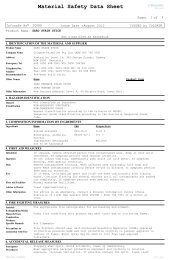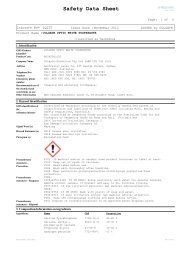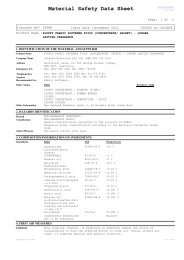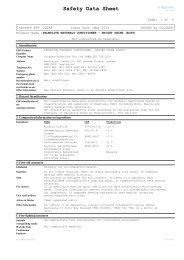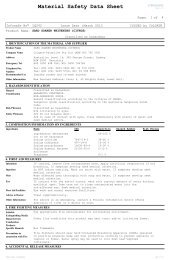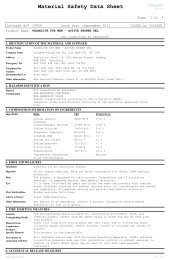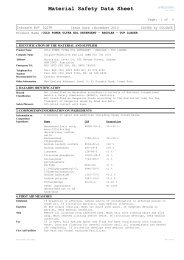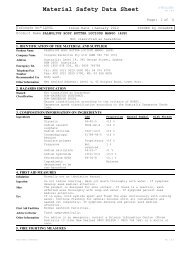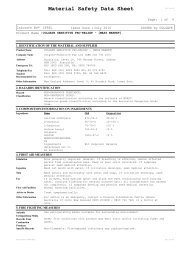Cold Power Powder - Colgate
Cold Power Powder - Colgate
Cold Power Powder - Colgate
Create successful ePaper yourself
Turn your PDF publications into a flip-book with our unique Google optimized e-Paper software.
Safety Data Sheet<br />
CS: 1.8.4<br />
Page: 1<br />
of<br />
4<br />
Infosafe No LQ0SA Issue Date : November 2013 ISSUED by COLGATE<br />
Product Name :COLD POWER MAXIMUM<br />
1. Identification<br />
GHS Product<br />
Identifier<br />
Company Name<br />
Address<br />
Telephone/Fax<br />
Number<br />
Emergency phone<br />
number<br />
Recommended use of<br />
the chemical and<br />
restrictions on use<br />
Other Names<br />
Other Information<br />
COLD POWER MAXIMUM<br />
<strong>Colgate</strong>-Palmolive Pty Ltd (ABN 002 792 163)<br />
Australia: Level 14, 345 George Street, Sydney<br />
NSW 2000 Australia<br />
Tel: AUS (02) 9229 5600 NZ: 04 576 6700<br />
Fax: AUS (02) 9229 5700, NZ: 04 568 8835<br />
AUS 1800 638 556, NZ: 0800 764766<br />
Laundry washing detergent.<br />
Name<br />
COLD POWER MAXIMUM TOP LOADER<br />
New Zealand Address: Level 4, 45 Knights Road, Lower Hutt.<br />
Product Code<br />
2. Hazard Identification<br />
Classification of the<br />
substance or mixture<br />
Classified as Hazardous according to criteria of National Occupational Health<br />
& Safety Commission, Australia (NOHSC).<br />
Not Classified as Dangerous Goods according to the Australian Code for the<br />
Transport of Dangerous Goods by Road and Rail. (7th edition)<br />
3. Composition/information on ingredients<br />
Ingredients<br />
4. First-aid measures<br />
Inhalation<br />
Ingestion<br />
Skin<br />
Eye contact<br />
First Aid Facilities<br />
Advice to Doctor<br />
Other Information<br />
5. Fire-fighting measures<br />
Suitable<br />
extinguishing media<br />
Name CAS Proportion<br />
Sodium carbonate 497-19-8 30-
Safety Data Sheet<br />
CS: 1.8.4<br />
Page: 2<br />
of<br />
4<br />
Infosafe No LQ0SA Issue Date : November 2013 ISSUED by COLGATE<br />
Product Name :COLD POWER MAXIMUM<br />
Hazards from<br />
Combustion<br />
Products<br />
Specific hazards<br />
arising from the<br />
chemical<br />
Precautions in<br />
connection with Fire<br />
6. Accidental release measures<br />
Personal<br />
precautions,<br />
protective equipment<br />
and emergency<br />
procedures<br />
7. Handling and storage<br />
Precautions for Safe<br />
Handling<br />
Conditions for safe<br />
storage, including<br />
any incompatabilities<br />
Corrosiveness<br />
Under fire conditions this product may emit toxic and/or irritating fumes<br />
including carbon monoxide and carbon dioxide.<br />
Non-flammable powder<br />
8. Exposure controls/personal protection<br />
Occupational<br />
exposure limit values<br />
Biological Limit<br />
Values<br />
Appropriate<br />
engineering controls<br />
Respiratory<br />
Protection<br />
Eye Protection<br />
Hand Protection<br />
Fire fighters should wear Self-Contained Breathing Apparatus (SCBA) operated<br />
in positive pressure mode and full protective clothing to prevent exposure to<br />
vapours or fumes. Water spray may be used to cool down heat-exposed<br />
containers.<br />
Increase ventilation. Evacuate all unprotected personnel. Wear sufficient<br />
respiratory protection and full protective clothing to prevent exposure. Sweep<br />
up material avoiding dust generation or dampen spilled material with water to<br />
avoid airborne dust, then transfer material to a suitable container. Wash<br />
surfaces well with soap and water. Seal all wastes in labelled plastic<br />
containers for subsequent recycling or disposal. Dispose of waste according to<br />
the applicable local and national regulations. If contamination of sewers or<br />
waterways occurs inform the local water and waste management authorities in<br />
accordance with local regulations.<br />
Use only in a well ventilated area. Keep containers sealed when not in use.<br />
Prevent the build up of dust in the work atmosphere. Avoid inhalation of dust,<br />
and skin or eye contact. Maintain high standards of personal hygiene i.e.<br />
Washing hands prior to eating, drinking, smoking or using toilet facilities.<br />
Store in a cool, dry, well-ventilated area, out of direct sunlight and<br />
moisture. Store in labelled, corrosion-resistant containers. Keep containers<br />
tightly closed. Store away from bases, water and other incompatible materials.<br />
Have appropriate fire extinguishers available in and near the storage area.<br />
Ensure that storage conditions comply with applicable local and national<br />
regulations.<br />
Not corrosive to metals.<br />
No exposure standards have been established for this material, however, the<br />
TWA exposure standards for dust not otherwise specified is 10 mg/m³. As with<br />
all chemicals, exposure should be kept to the lowest possible levels. TWA<br />
(Time Weighted Average): The average airborne concentration of a particular<br />
substance when calculated over a normal eight-hour working day, for a five-day<br />
week. Source: Safe Work Australia<br />
No biological limit allocated.<br />
Not required for domestic use. For industrial applications: Provide sufficient<br />
ventilation to keep airborne levels below the exposure limits. Where dusts are<br />
generated, particularly in enclosed areas, and natural ventilation is<br />
inadequate, a local exhaust ventilation system is required.<br />
Not required for domestic use. For industrial applications: If engineering<br />
controls are not effective in controlling airborne exposure then an approved<br />
respirator with a replaceable dust/particulate filter should be used.<br />
Reference should be made to Australian/New Zealand Standards AS/NZS 1715,<br />
Selection, Use and Maintenance of Respiratory Protective Devices; and AS/NZS<br />
1716, Respiratory Protective Devices, in order to make any necessary changes<br />
for individual circumstances.<br />
Not required for domestic use. For industrial applications: The use of<br />
chemical goggles or safety glasses with side shield protection is recommended<br />
if there is a risk of eye exposure. Final choice of appropriate eye/face<br />
protection will vary according to individual circumstances i.e. methods of<br />
handling or engineering controls and according to risk assessments undertaken.<br />
Eye protection should conform with Australian/New Zealand Standard AS/NZS 1337<br />
- Eye Protectors for Industrial Applications.<br />
Wear gloves of impervious material. Final choice of appropriate gloves will<br />
Print Date: 22/11/2013 CS: 1.8.4
Safety Data Sheet<br />
CS: 1.8.4<br />
Page: 3<br />
of<br />
4<br />
Infosafe No LQ0SA Issue Date : November 2013 ISSUED by COLGATE<br />
Product Name :COLD POWER MAXIMUM<br />
Body Protection<br />
9. Physical and chemical properties<br />
Appearance<br />
Odour<br />
Melting Point<br />
Boiling Point<br />
Solubility in Water<br />
Specific Gravity<br />
pH<br />
Vapour Pressure<br />
Vapour Density<br />
(Air=1)<br />
Flash Point<br />
Flammability<br />
Auto-Ignition<br />
Temperature<br />
Flammable Limits -<br />
Lower<br />
Flammable Limits -<br />
Upper<br />
vary according to individual circumstances i.e. methods of handling or<br />
according to risk assessments undertaken. Reference should be made to AS/NZS<br />
2161.1: Occupational protective gloves - Selection, use and maintenance.<br />
Not required for domestic use. For industrial applications: Suitable<br />
protective work wear, e.g. cotton overalls buttoned at neck and wrist is<br />
recommended. Chemical resistant apron is recommended where large quantities<br />
are handled.<br />
White powder<br />
Not available<br />
Not available<br />
Not available<br />
Soluble<br />
0.78<br />
10. Stability and reactivity<br />
Chemical Stability<br />
Conditions to Avoid<br />
Incompatible<br />
Materials<br />
Hazardous<br />
Decomposition<br />
Products<br />
Hazardous<br />
Polymerization<br />
9.0-11.0 (1% solution)<br />
Not applicable<br />
Not applicable<br />
Not applicable<br />
Non-combustible<br />
Not available<br />
11. Toxicological Information<br />
Toxicology<br />
Information<br />
Ingestion<br />
Inhalation<br />
Skin<br />
Eye<br />
Chronic Effects<br />
12. Ecological information<br />
Not applicable<br />
Not applicable<br />
Stable under normal conditions of use and storage.<br />
Extremes of temperature and direct sunlight. Dust accumulation.<br />
Strong oxidising agents.<br />
Thermal decomposition may result in the release of toxic and/or irritating<br />
fumes including carbon monoxide and carbon dioxide.<br />
Will not occur.<br />
No toxicity data available for this product.<br />
Ingestion of this product may irritate the gastric tract causing nausea and<br />
vomiting.<br />
Inhalation of product dusts may cause irritation of the nose, throat and<br />
respiratory system.<br />
Skin contact may cause mechanical irritation resulting in redness and itching.<br />
Irritating to eyes. On eye contact this product will cause tearing, stinging,<br />
blurred vision, and redness.<br />
Repeated or prolonged exposure to this material may cause skin sensitisation<br />
in some individuals. Inhalation of enzyme dust or aerosols resulting from<br />
handling may induce sensitisation and may cause allergic reactions in<br />
sensitized individuals. Prolonged skin contact may cause minor irritation.<br />
Print Date: 22/11/2013 CS: 1.8.4
Safety Data Sheet<br />
CS: 1.8.4<br />
Page: 4<br />
of<br />
4<br />
Infosafe No LQ0SA Issue Date : November 2013 ISSUED by COLGATE<br />
Product Name :COLD POWER MAXIMUM<br />
Ecotoxicity<br />
Persistence and<br />
degradability<br />
Mobility<br />
Bioaccumulative<br />
Potential<br />
Environmental<br />
Protection<br />
13. Disposal considerations<br />
Disposal<br />
Considerations<br />
14. Transport information<br />
Transport<br />
Information<br />
15. Regulatory information<br />
Regulatory<br />
Information<br />
Poisons Schedule<br />
Hazard Category<br />
AICS (Australia)<br />
16. Other Information<br />
Date of preparation<br />
or last revision of<br />
SDS<br />
Literature<br />
References<br />
Contact Person/Point<br />
No ecological data are available for this material.<br />
Not available<br />
Not available<br />
Not available<br />
Prevent this material entering waterways, drains and sewers.<br />
The disposal of the spilled or waste material must be done in accordance with<br />
applicable local and national regulations.<br />
Road and Rail Transport (ADG Code):<br />
Not classified as Dangerous Goods according to the Australian Code for the<br />
Transport of Dangerous Goods by Road and Rail (ADG Code) (7th edition).<br />
Marine Transport (IMO/IMDG):<br />
Not classified as Dangerous Goods by the criteria of the International<br />
Maritime Dangerous Goods Code (IMDG Code) for transport by sea.<br />
Air Transport (ICAO/IATA):<br />
Not classified as Dangerous Goods by the criteria of the International Air<br />
Transport Association (IATA) Dangerous Goods Regulations for transport by air.<br />
Classified as Hazardous according to criteria of National Occupational Health<br />
& Safety Commission (NOHSC), Australia.<br />
Not classified as a Scheduled Poison according to the Standard for the Uniform<br />
Scheduling of Medicines and Poisons (SUSMP).<br />
Not Scheduled<br />
Irritant<br />
All components of this product are listed on the Australian Inventory of<br />
Chemical Substances (AICS) or exempted.<br />
MSDS Reviewed: November 2013<br />
Supersedes: January 2012<br />
Standard for the Uniform Scheduling of Medicines and Poisons.<br />
Approved criteria for classifying hazardous substances [NOHSC:1008(2004)].<br />
National Code of Practice for the Preparation of Material Safety Data Sheets<br />
[NOHSC:2011(2003)].<br />
Australian Code for the Transport of Dangerous Goods by Road & Rail.<br />
Model Work Health and Safety Regulations, Schedule 10: Prohibited<br />
carcinogens, restricted carcinogens and restricted hazardous chemicals.<br />
Workplace exposure standards for airborne contaminants, Safe work Australia.<br />
American Conference of Industrial Hygienists (ACGIH).<br />
24Hr Emergency Response<br />
Australia- 1800 638 556<br />
New Zealand- 0800 764 766<br />
...End Of MSDS...<br />
© Copyright ACOHS Pty Ltd<br />
Copyright in the source code of the HTML, PDF, XML, XFO and any other electronic files rendered by an Infosafe system for Infosafe MSDS displayed is the intellectual<br />
property of Acohs Pty Ltd.<br />
Copyright in the layout, presentation and appearance of each Infosafe MSDS displayed is the intellectual property of Acohs Pty Ltd.<br />
The compilation of MSDS's displayed is the intellectual property of Acohs Pty Ltd.<br />
Copying of any MSDS displayed is permitted for personal use only and otherwise is not permitted. In particular the MSDS's displayed cannot be copied for the purpose of<br />
sale or licence or for inclusion as part of a collection of MSDS without the express written consent of Acohs Pty Ltd.<br />
Print Date: 22/11/2013 CS: 1.8.4



